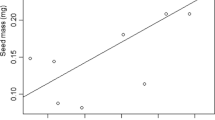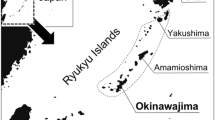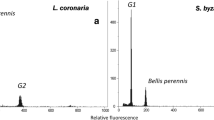Summary
Ecotypes of Galium spurium L. var. echinospermon with distinct germination phenologies were found to occur in two adjacent plots of a grassland nature reserve with different management histories: a spring-germinating population is present in a winter-burnt plot, and an autumn-germinating type in an unburnt plot. These ecotypes share common flowering and fruiting phenologies, and disperse their seeds in early summer. Markedly contrasting thermal dormancy/germination characteristics were demonstrated for their seeds in systematic laboratory tests performed after several types of seed storage including storage in the field. The primary dormancy of seeds of the spring germinator was removed by moist-chilling or field winter-chilling, while that of the autumn germinator was removed by moist storage at 25°C or field summer temperatures. Biseasonal seedling emergence of the species appears to be due to a local differentiation of distinct ecotypes.
Similar content being viewed by others
References
Allard RW, Babbel GR, Clegg MT, Kahler AL (1972) Evidence for coadaptation in Avena barbata. Proc Nat Acad Sci 69: 3043–3048
Ankei T (1989) Phenology and life cycles of Stellaria (Caryophyllaceae) with special reference to the evolution of their life forms. J Phytogeogr Taxon 37: 43–52
Antonovics J (1968) Evolution in closely adjacent plant populations. V. Evolution of self-fertility. Heredity 23: 219–238
Baskin CC, Baskin JM (1988) Germination ecophysiology of herbaceous plant species in a temperate region. Am J Bot 75: 286–305
Bradshaw AD (1971) Plant evolution in extreme environments. In: Creed R (ed) Ecological genetics and evolution, Blackwell Scientific Publications, Oxford, pp 20–50
Cohen D (1966) Optimizing reproduction in a randomly varying environment. J Theor Biol 12: 119–129
Cohen D (1968) A general model of optimizing reproduction in a randomly varying environment. J Ecol 56: 219–228
Cook RE (1979) Patterns of juvenile mortality and requirement in plants. In: Solbrig OT, Jain S, Johnson G, Raven PH (eds) Topics in plant population biology, Columbia University Press, New York, pp 207–231
Fenner M (1985) Seed Ecology. Chapman and Hall, London
Fenner M (1987) Seedlings. New Phytol 106: 35–47
Grime JP, Mason G, Curtis AV, Random J, Band SR, Mowforce MAG, Neal AM, Shaw S (1981) A comparative study of germination characteristics in a local flora. J Ecol 69: 1017–1059
Gross KL (1980) Colonization by Verbascum thapsus (Mullein) of an oldfield in Michigan: experiments on the effects of vegetation. J Ecol 68: 919–927
Harper JL (1977) Population Biology of Plants. Academic Press, London
Leon JA (1985) Germination strategies. In: Greenwood PJ, Harvey PH, Slatkin M (eds) Evolution, Cambridge University Press, New York, pp 129–142
Masuda M, Washitani I (1990) A comparative ecology of the seasonal schedules for “reproduction by seeds” in a moist tall grassland community. Funct Ecol 4: 169–182
Marks M, Prince S (1981) Influence of germination date on survival and fecundity in wild lettuce Lactuca serriola. Oikos 36: 326–330
Schmitt J, Gamble SE (1990) The effect of distance from the parental site on offspring performance and inbreeding depression in Impatiens capensis: a test of the local. Evolution 44: 2022–2030
Silvertown JW (1985) When plants play in the field. In: Greenwood PJ, Harvey PH, Slatkin M (eds) Evolution, Cambridge University Press, New York, pp 143–153
Silvertown JW, Dickie JB (1980) Seedling survivorship in natural populations of nine perennial chalk grassland plants. New Phytol 88: 555–558
Solbrig OT (1980) Demography and Natural Selection. In: Solbrig OT (ed), Demography and Evolution in Plant Strategy, Blackwell, Oxford, pp 1–20
Stanton M (1985) Seed size and emergence time within a stand of wild radish (Raphanus raphanistrum L.): the establishment of a fitness hierarchy. Oecologia 67: 524–531
Ueki K (1965) Phisiological and ecological studies on clever (Gariume aparine L.) contorol. Graduation Thesis. Univ. Kyoto. Kyoto, Japan.
Venable DL (1985) The evolutionary ecology of seed heteromorphism. Am Nat 126: 577–595
Washitani I (1987) A convenient screening test system and a model for thermal germination responses of wild plant seeds: behavior of model and real seeds in the system. Plant Cell Env 10: 587–598
Washitani I, Kabaya H (1988) Germination responses to temperature responsible for the seedling emergence seasonality of Primula sieboldii E. Morren in its natural habitat. Ecol Res 3: 9–20
Westoby M (1981) How diversified seed germination behavior is selected. Am Nat 118: 882–885
Author information
Authors and Affiliations
Rights and permissions
About this article
Cite this article
Masuda, M., Washitani, I. Differentiation of spring emerging and autumn emerging ecotypes in Galium spurium L. var. echinospermon . Oecologia 89, 42–46 (1992). https://doi.org/10.1007/BF00319013
Received:
Accepted:
Issue Date:
DOI: https://doi.org/10.1007/BF00319013




